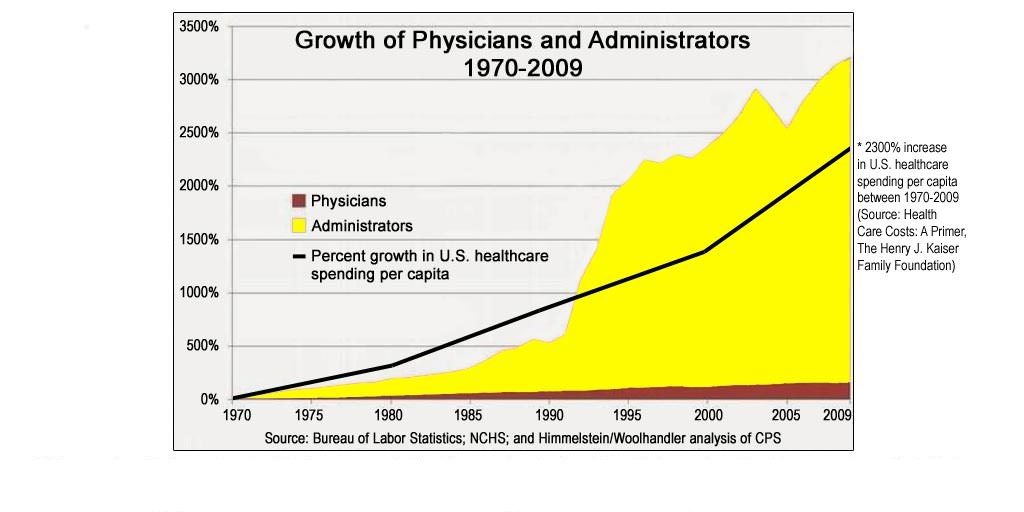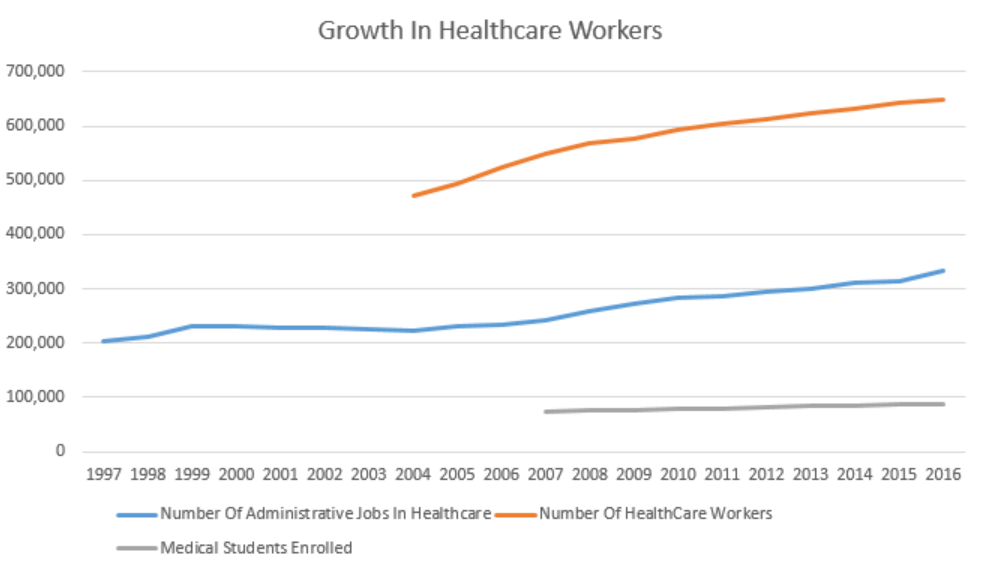The Growth Of Administrators In Health Care
I’ve recently seen a graph that was pretty jarring to say the least. The graph below has been copied in many different articles in the past years. The main claim in this graph is about explosive growth of administrators in health care positions. The growth of administration has increased since Medicaid and Medicare came into effect. However, I cant help but wonder how much of the growth is overblown or real. Lets take a look at some recent numbers to make up our own mind.
The Chart That Depicts Growth Of Physicians And Administrators In Health Care

Graphic adapted from this article
This graph has two red flags.
- First: Data is represented as percent growth in jobs. Not the actual number of people employed.
- Second: Anytime a graph shows a 3,000% change in one direction, I can’t help but ask myself if things may seem too good to be true. (If an investor claims to always beat the market, you should be seeing red flags too.)
Representing Jobs As Percent Growth
The problem with representing data as percent growth is that it tells us little as to how big the market really is. If there were initially 50 jobs, are there now 1700 jobs? Were there initially 50,000 health care administrators in 1970 compared to the 328,020 active physicians (a ratio of 6.5 doctors to every 1 administrator)? IF that was the case, then a 3,000 % increase would equal about 2,000,000 administrators in medicine by the year 2009.
According to the Bureau of Labor and Statistics website, at this time data online only dates back to the 80’s. However, based on the data as described below, for the graph above to be 100% accurate there would have been about 9,000 health care administrator jobs in health care in 1970. I find it hard to believe that there were only 9,000 administrative jobs available in 1970. If it is accurate, then each state would have about 180 administrative jobs in 1970 reported to the Bureau of Labor and Statistics.
The Growth In Administrative Jobs
The large growth in administrative jobs coincides with the enactment of Medicare and Medicaid. Suddenly, there was a large need for administrative jobs like never seen before. As more and more legislature passed, the more the need for administrative jobs in health care. The Clinton health care plan in 1993 brought a lot of attention to an industry filled with ballooning costs. The plan ultimately failed, but it heightened the focus on health care spending in the United States. As we have subsequently learned, this debate on how to control costs continues to this date.
A look At Administrative Job Growth Vs Number Of Health Care Workers vs Medical Student Enrollment

Note that the dates do not all completely match up since healthcare workers listed on the government website until about 2004 didn’t seem to include nurse practitioners or other advanced degrees that assist physicians in health care. Source of the data comes directly from the United States Bureau of Labor and Statistics website uploaded into an excel document and charted as a graph.
- Blue Line: The overall growth in administrative jobs in health care from 1997 to 2016 was 63%, or 128,730 jobs.
- Orange Line: Individuals working in healthcare (non administrative roles) increased by 178,460 jobs or 37%.
- The majority of the growth in this is due to nurse practitioners and physician assistants becoming more popular over time.
- Grey Line: Medical students enrolled in the United States increased by 19%.
Administrative Jobs In Healthcare. No End In Sight To The Growth
According to one study, the United States spends 39% more on administrative costs compared to Canada in 2011. I think it’s interesting that each year physicians make the news about potential cuts to reimbursements. However, outside of the doctors lounge, no one really talks about administrative costs. I will admit, the problem is not black and white. Grouping all administrative jobs together as unnecessary would be a gross over exaggeration. However, a 63% increase in number of jobs over the last 9 years points to a very quickly expanding market!
The one area that I am happy to see growth in is nurse practitioners and physician assistants. These advanced degrees have largely led the growth of actual health care workers listed on the graph above.
Limitations Of This Post
This post has several limitations to its data presented that I at least have to mention. The United States Bureau of Labor and Statistics have their data listed as somewhat black and white. There are a lot of physicians who have dual roles in administration and as a clinical provider. The data does not make it clear how they divide doctors who have these two roles. No definition of how this was dealt with was listed on the website.
Another limitation is that the data unfortunately does not go back to the 1970’s on the website. Information in articles about exact numbers of administrators in health care is scant in the 1970’s. The first graph listed above has citations on several different websites. However, those citation are also quite vague and difficult to determine exactly where the data was pulled from. This is another large limitation to my comparison to the data listed above. Despite this, all data that I have found has come directly from the Bureau of Labor and Statistics website.
Going Forward:
Practicing medicine can feel like I have numerous different bosses. This feeling arises when insurance companies require pre-authorization for certain medications. It also occurs when I get asked by administration why a patient has not been discharged by 9am in an effort to improve efficiency in the hospital bed turnover. I feel as physicians we are slowly losing our autonomy as a practicing physician and pushed by administrative metrics.
I’ll take a step back and say that not all administrators are bad. Someone has to look after budgets and ensure that the lights stay on. However, our search for improved outcomes usually ends up adding to administrative bloatware. Somewhere a consultant is hired to fix a problem. These consultants will usually have one of two recommendations. Cut costs by eliminating services or inefficiencies, or increase income by hiring more people to improve efficiency (administrative jobs) or focusing on higher revenue services.
Hopefully with time, the electronic age will reach a point where instead of adding more complicated processes, that many of these administrative roles will become inefficiencies themselves.
What are your thoughts on the number of jobs as administrators in health care? Do you think the increase is bigger than what is represented above? I’m interested to hear your thoughts.





This Is quite depressing. Oh well we all feel it in medicine and there is no escaping it.
Pingback: The growth of administrators in health care | Epistle of Dude
Pingback: Risk-based Auditing Software Helps Keep Healthcare Spending Under Control – Quebec Daily Examiner
Pingback: Risk-based Auditing Software Helps Keep Healthcare Spending Under Control – The Daily Telescope
Pingback: Risk-based Auditing Software Helps Keep Healthcare Spending Under Control – Canadian Business Tribune
Pingback: Healthcare Administration: A Lesser Known Job – NhiaUWP01
Pingback: SocialPanic
I’m so glad you’re excited that people with 3% of our training are preferentially being hired over us, making it harder for patients to access physicians…
I’m guessing that’s another income stream for you…
I’m not excited about it. I made the post to call out a graph that is poorly made and dug deeper myself into the number to say, yes the number of jobs for admin is rising but the graph is misleading.
A couple of comments. First, “the business of healthcare” has led to a ridiculous number of layers of administration. My institution recently decided that the problem with nursing dissatisfaction was that there were not enough nursing administrators! Pretty sure we are 5-6 layers deep in administration while they bitch about the doctors income. Second- NPs and PAs are not a bad thing. As long as they function as actual extenders, it works. When they wish to be doctors or we give them that autonomy, we harm ourselves.
Pingback: Is Health Care in the US the Best? - Fair Observer - GulfJobUpdate
Pingback: Health Care in America Is the Best in the World - Fair Observer - GulfJobUpdate
Pingback: Health Care in America Is the Best in the World - Fair Observer - Directly News - Daily New Updates From Worldwide
One of my favorite graphs. https://investingdoc.com/wp-content/uploads/2017/08/admin-jobs-1024×512.jpg Administration is bloated and they have no clue nor interest in empowering medicine and nursing to create the best health care. They have their hands on the money, thus they have the power, so they think they are privileged and superior to the rest of humanity. They get VIP when they have to go to the hospital, so they never touch the same ground as everyone else. Scripting seems to be the trend in health and education. Teachers are scripted, so why would you even hire people who know to assess and teach? Nurses and doctors are scripted and limited by administration’s check the box, algorithms, AI, “MothermayI”, delay-deny, understaffing. Soon doctors will be superfluous; the administrators will simply push a button for diagnosis/Rx/Tx, and crack the whip on understaffed nurses. Very sick patients will be discharged to home under threat of lawsuit under the Home All Alone plan. Costs will continue to rise, quality will continue to fall, administrators will continue to proliferate, more patients will die, new laws will be passed to prevent lawsuits against hospitals, nonprofits will continue to get tax-free benefits while not meeting their charity obligations. So far, administrators are riding on the backs of the licensed personnel who have no idea of their power. Maybe MDs and RNs will all strike and take over the power of the purse, cut the bloated administration, and recreate administration in service to the mission of health care. It is the season of unions so that could happen. What do you think?